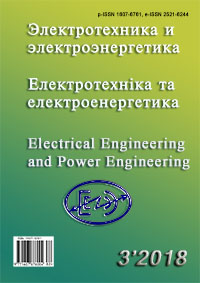TOPOLOGICAL REVERSIBLE MODEL OF THREE-PHASE FIVE-LIMB TRANSFORMER
DOI:
https://doi.org/10.15588/1607-6761-2018-3-1Keywords:
five-limb transformer, topological model, reversible transient model, current waveforms, experi-mental validation, geomagnetically-induced currents, transformer test, inrush currentsAbstract
Purpose. The paper continues the authors’ studies devoted to transients in three-phase five-limb transformers. The main purpose of the work is to propose a method of evaluating model parameters, which cover transformer operations in saturation. This purpose is achieved by using the concept of the model reversibility.
Methodology. The method of obtaining model parameters employs magnetic transformer model and is based on the idea of the model reversibility. The solution is found by equating input reluctances seen from the terminals of the innermost and outermost windings to the reluctances of the corresponding windings on air.
Findings. The modeling of GIC events represented in the paper is the most accurate ever obtained for three-phase, five-leg transformers. The model is validated by close agreement of the predicted values and waveforms of the phase currents and reactive power with those measured in tests performed on two 400 MVA transformers connected back-to-back and to a 400 kV power network. The validity of the model was verified at 75 and 200 A dc currents in the transformer neutral. It is shown that the model is a reliable tool in evaluating inrush currents.
Originality. The originality and advantage of the method proposed is its ability to determine the model parameters without fitting to experimental data obtained in regimes with highly saturated core. The method ensures the reversibility of the three-winding transformer model that is its correct behavior regardless of which winding is energized.
Practical value. The practical value and significance of the paper is caused by the fact that the model proposed is a simple and reliable tool for power system studies. As a practically important example, time domain response of transformer subjected to geomagnetically induced currents (GIC) is analyzed and compared with results of a comprehensive field experiment.
References
[1] Zirka, S., Moroz, Y., Arturi, C., & Bonnman, D. (2018). Topological transient models of three-phase five-limb transformer. Electrical Engineering And Power Engineering, 2, 18-25. doi:http://dx.doi.org/10.15588/1607-6761-2017-2-2
[2] Arturi, C. M. (1991). Transient simulation of a three phase five limb step-up transformer following an out-of-phase synchronization. IEEE Trans. Power Delivery, 6, 1, 196-207. doi: http://dx.doi.org/10.1109/61.103738
[3] Chen, X., Venkata, S.S. (1997). A three-phase three winding core-type transformer model for low frequency transient studies. IEEE Trans. Power Delivery, 12, 2, 775-782. doi: http://dx.doi.org/0885-8977/97/$10.00
[4] Walling, R. A., Khan, A. H. (1991). Characteristics of transformer exciting current during geomagnetic disturbances. IEEE Trans. Power Delivery, 6, 4, 1707-1714. doi: 0885-8977/91$01.00
[5] Zirka, S. E., Moroz, Y. I., Arturi, C. M., Chiesa, N., Høidalen, H. K. (2012). Topology-correct reversible transformer model. IEEE Trans. Power Delivery, 27, 4, 2037-2045. doi: http://dx.doi.org/10.1109/TPWRD.2012.2205275
[6] Jazebi, S., Leόn, F. de, Farazmand, A., Deswal D. (2013). Dual reversible transformer model for the calculation of low-frequency transients. IEEE Trans. Power Delivery, 28, 4, 2509-2516. doi:http://dx.doi.org/10.1109/TPWRD.2013.2268857
[7] Jazebi, S., Leόn, F. de. (2015). Experimentally validated reversible singe-phase multiwinding transformer model for the accurate calculation of low-frequency transients. IEEE Trans. Power Delivery, 30, 1, 193-201. doi:http://dx.doi.org/10.1109/TPWRD.2014.2319093
[8] Lahtinen, M., Elovaara, J. (2002). GIC occurrences and GIC test for 400 kV system transformer. IEEE Trans. Power Delivery, 17, 2, 555-561. doi:http://dx.doi.org/0885-8977(02)02750-4.
[9] Yang, M., Kazemi, R., Jazebi, S., D. Deswal, Leon, F. De. (2018). Retrofitting the BCTRAN transformer model with non-linear magnetizing branches for the accurate study of low-frequency deep saturating transients. IEEE Trans. Power Delivery, 5, 33, 2344-2353. doi:http://dx.doi.org/10.1109/TPWRD.2018.2825252
[10] Alexander Ch., Sadiku M., (2013). Fundamentals of electric circuits, 5th edition. New York, NY, USA: McGraw-Hill.
[11] Høidalen, H. K., Mork, B. A., Gonzalez, F., Ishchenko, D., Chiesa, N. (2009). Implementation and verification of the hybrid transformer model in ATPDraw, Electric Power Systems Research, 79, 3, 454-459. doi: http://dx.doi.org/10.1016/j.epsr.2008.09.003
[12] Moroz, Y. I., Zirka, S. E. (2014). Inverse models of magnetic hysteresis, [Online]. Available: https://sites.google.com/site/inverse-hysteresismodel.
[13] Alternative Transients Program, ATP-EMTP. (2016). [Online]. Available: http://www.eeug.org
[14] S. Jazebi, A. Rezaei-Zare, M. Lambert, et al. (2016). Duality-derived transformer models for low-frequency electromagnetic transients—Part II: Complementary modeling guidelines. IEEE Trans. Power Delivery, 31, 5, 2420-2430. doi: http://dx.doi.org/10.1109/TPWRD.2016.2556686
[15] Zirka, S. E., Moroz, Y. I., Høidalen, H. K., Lotfi, A., Chiesa, N., Arturi, C. M. (2017). Practical experience in using a topological model of a core-type three-phase transformer—no-load and inrush conditions. IEEE Trans. Power Delivery, 32, 4, 2081-2090. doi:http://dx.doi.org/10.1109/TPWRD.2016.2618900
Downloads
Published
How to Cite
Issue
Section
License
Copyright (c) 2018 S. E. Zirka, Y. I. Moroz, C.M. Arturi, J. Elovaara, M. Lahtinen

This work is licensed under a Creative Commons Attribution 4.0 International License.
Creative Commons Licensing Notifications in the Copyright Notices
Authors who publish with this journal agree to the following terms:
Authors retain copyright and grant the journal right of first publication with the work simultaneously licensed under aCreative Commons Attribution License that allows others to share the work with an acknowledgement of the work's authorship and initial publication in this journal.
Authors are able to enter into separate, additional contractual arrangements for the non-exclusive distribution of the journal's published version of the work (e.g., post it to an institutional repository or publish it in a book), with an acknowledgement of its initial publication in this journal.
Authors are permitted and encouraged to post their work online (e.g., in institutional repositories or on their website) prior to and during the submission process, as it can lead to productive exchanges, as well as earlier and greater citation of published work.

